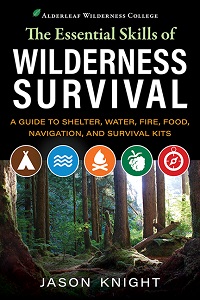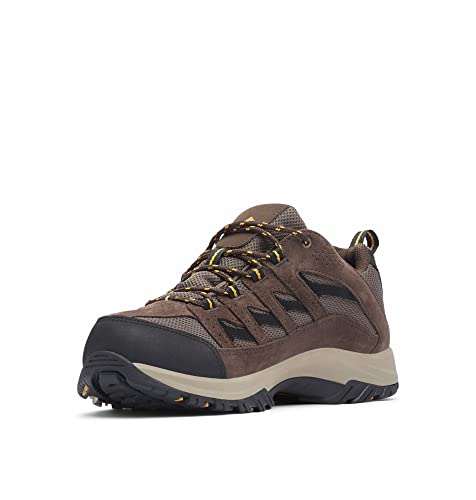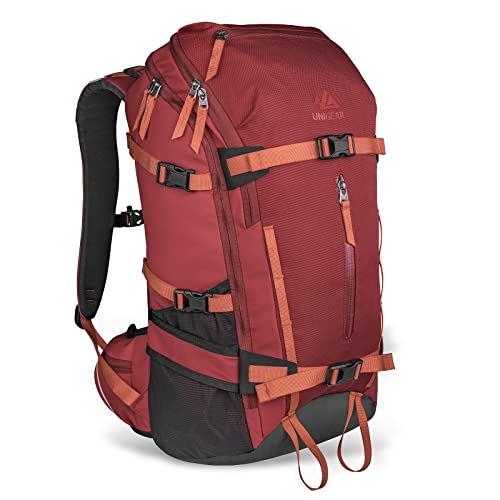Embark on an unforgettable outdoor experience. Start your adventure and discover the hidden wonders of nature with our best hiking tips for beginners. Get ready to embrace adventure like never before!
This post contains some affiliate links to products that I use and love. If you click through and make a purchase, I’ll earn a commission, at no additional cost to you. Read my full disclosure here.
But before you venture out, it’s important to equip yourself with the right knowledge and gear. In this article, we will provide you with the best hiking tips for beginners – everything you need to know to make your hiking experience safe, enjoyable, and unforgettable.
From essential gear and planning trails to safety tips and etiquette, we’ve got all bases covered so that you can hike with confidence and embrace the liberating feeling of being one with nature.
In This Article
Key Takeaways
- Research and plan ahead: Before starting a hike, it is important to research the trail, check park regulations, and understand any permits or logistics.
- Train and prepare: Training for hiking can involve cardio exercises like walking or running, strength training, yoga and stretching, and gradually increasing the difficulty of hikes.
- Find hiking companions: Hiking with companions can enhance the experience and provide an added level of safety.
- Follow hiking etiquette and safety guidelines: Hikers should follow trail etiquette by being considerate of other hikers, bikers, and horses. This includes following right of way rules, not screaming or shouting on the trail, and allowing others to pass.
Best Hiking Tips For Beginners: Here’s What To Know
It’s no wonder why hiking has become such a popular outdoor activity for beginners.
Not only does it offer a chance to disconnect from technology and embrace the beauty of nature, but it also provides an opportunity for physical fitness and mental rejuvenation.
However, proper preparation and knowledge are key to ensuring a successful hike. That’s why it’s important to understand the basics of hiking, including finding suitable trails, training your body for the challenges ahead, packing the right gear, and following trail etiquette.
So get ready to lace up your boots and embark on an adventure that will leave you energized and inspired!
Exploring the appeal and popularity of hiking for beginners
Discover why hiking has become so popular among beginners like yourself. It’s not just about disconnecting from technology, but also about embracing the therapeutic benefits and rewarding experiences that come with exploring the great outdoors.
Hiking offers numerous benefits for your mental health. Spending time in nature can reduce stress, improve mood, and increase feelings of happiness and well-being. It provides an opportunity to escape the hustle and bustle of everyday life and find inner peace.
If you have fears or concerns about hiking, remember that everyone starts as a beginner. Start small with easy trails and gradually challenge yourself as your confidence grows.
Finding motivation to start hiking can be as simple as setting goals, finding a hiking buddy or group, or seeking inspiration from nature photography or adventure stories.
So lace up those shoes, hit the trails, and discover the freedom and joy that hiking can bring to your life!
Emphasizing the need for proper preparation and knowledge
Make sure you’re well-prepared and knowledgeable about hiking before hitting the trails, as proper preparation and understanding can greatly enhance your experience and ensure your safety.
Preparing for success is crucial, so take the time to assess your fitness level and know your limits. Start with beginner-friendly trails that are under 5 miles in length and have minimal elevation gain.
Research the trail beforehand, check park regulations, and understand any permits or logistics involved.
Knowing what to expect will help you pack the right gear, including the 10 Essentials, a sturdy backpack, water, hiking shoes, and appropriate clothing.
It’s also important to research seasonal constraints and check the weather forecast before heading out.
By taking these steps and being well-informed, you’ll be able to enjoy your hike with confidence and make the most of your outdoor adventure.
Essential Gear for Beginner Hikers
When it comes to essential gear for beginner hikers, there are a few key points to consider.
First and foremost is hiking footwear – choosing the right shoes and socks can make all the difference in your comfort and safety on the trail.
Next, selecting and packing your backpack effectively is crucial for carrying all your gear without straining your body.
Additionally, understanding layering techniques and wearing appropriate attire for different weather conditions will keep you comfortable throughout your hike.
Lastly, don’t forget about navigation tools like maps, compasses, and GPS devices – they can help you stay on track and avoid getting lost in unfamiliar terrain.
Remember these tips as you prepare for your first hiking adventure!
Hiking footwear: Choosing the right shoes and socks
Hiking footwear plays a crucial role in ensuring comfort and safety on the trails, so it’s important to choose the right shoes and socks.
When it comes to choosing the right footwear, there are a few key factors to consider. First, think about the type of hiking you’ll be doing and the terrain you’ll encounter.
For beginners, a sturdy pair of sneakers with good traction is usually sufficient for easy trails. If you plan on tackling more advanced trails or backpacking trips, investing in hiking boots may be necessary for added support and protection.
Our Recommended Shoes For Men
- Pigskin leather and mesh upper 100% recycled laces and webbing Bellows tongue keeps out debris Protective toe cap 100% recycled mesh lining Kinetic Fit ADVANCED removable contoured insole with reinforced heel cushioning for medium support Molded nylon arch shank Merrell Air Cushion in the heel absorbs shock and adds stability Lightweight EVA foam midsole for stability and comfort Vibram TC5+ rubber sole
- Pigskin leather and mesh upper
- Traditional lace closure
- ADVANCED TECHNOLOGY: The Crestwood Waterproof Hiking Shoe features our Omni-TECH waterproof bootie construction, combined with our TECHLITE lightweight midsole, for long-lasting comfort with superior cushioning and high energy return.
- DURABLE HIKING SHOE: The perfect combination of high function and performance designed into a hiking shoe. This all-purpose hiker will deliver nimble and comfortable service.
I use to wear a good pair of sneakers when I hiked, However, when we first moved to Colorado, I realized I needed something made for more strenuous trails. My wife found a great deal on a pair of Merrell hiking shoes. I’ve had them for years, and totally satisfied.
I learned the value of a good pair of hiking boots or shoes.
Our Recommended Shoes For Women
- ADVANCED TECHNOLOGY: The Newton Ridge Plus Waterproof Amped Hiking Boot features a seam-sealed construction, combined with our TECHLITE lightweight midsole, for long-lasting comfort with superior cushioning and high energy return.
- DURABLE HIKING BOOT: This women’s boot is inspired by classic mountaineering style. A durable mid cut waterproof hiker that provides great traction and comfort. This classic Columbia hiking boot, will deliver years of comfortable service.
- Pigskin leather and mesh upper 100 percent recycled laces and webbing Bellows tongue keeps out debris Protective toe cap 100 percent recycled mesh lining Kinetic Fit ADVANCED removable contoured insole with reinforced heel cushioning for medium support Molded nylon arch shank Merrell Air Cushion in the heel absorbs shock and adds stability Lightweight EVA foam midsole for stability and comfort Vibram TC5+ rubber sole
- Mesh and TPU upper
- Traditional lace closure
Proper socks are also essential for a comfortable hiking experience. Look for socks made from moisture-wicking materials like merino wool or synthetic blends that help keep your feet dry and prevent blisters.
Avoid cotton socks as they tend to retain moisture and can lead to discomfort.
Finding the right fit is paramount when choosing hiking footwear. Make sure to try on different styles and brands to find one that feels snug but not too tight.
Also, take into account any foot conditions or specific needs you may have, such as arch support or wide toe boxes.
By selecting appropriate footwear and pairing it with quality socks, you’ll be well-equipped for your hiking adventures while ensuring optimal comfort and foot health along the way.
Backpack: Selecting and packing your backpack effectively
To ensure a successful hiking experience, it’s crucial that you carefully select and pack your backpack, maximizing its efficiency and functionality.
Backpack organization is key to easily accessing your gear while on the trail. Start by choosing a lightweight backpack option that suits your needs.
Look for packs made from durable materials with ample storage compartments and pockets.
When selecting the right backpack size, consider the length of your hikes and the amount of gear you plan to carry. A 20-30 liter pack is generally sufficient for day hikes, while longer trips may require a larger capacity.
- 【Well Made & Durable】SKYSPER ISHELL30Ⅱ packable compact backpack for travel is made from highly rip and water resistant 210D fabric to provide strengthen and long-lasting performance with minimal weight. Very high quality construction with quality parachute style fabric and strong stitching.
- 【Lightweight & Foldable】This packable super lightweight travel backpack only weighs 0.88lbs but has a capacity of 30litres. When hiking backpack men packable is not needed for use, the roomy daypack lightweight backpack with 2 water pockets can be folded into a space-saving backpack within few easy steps with strong and smooth SBS zippers. The folded size is only 8.2inch x 7.5inch.
- 【Unique Design Backpack】Hiking backpack in expandable version. Large capacity & lightweight hiking daypack. Before extension:14 x 8 x 21.5 inch (40L). After extension:14 x 8 x 25.5 inch (50L)
- 【Expandable & Extra Large Capacity】SEMSTY hiking backpack can be expanded by using the zipper at the bottom (from 40L to 50L). Roomy enough for a CARRY ON. The side buckles make your stuffs safe and make the backpack not too bulged even it’s fully packed. Multi-compartments can hold everything you need in travels, such as phone, bottles, umbrella or camping supplies etc. You can easily organize all your essential stuffs. An outdoor backpack perfect for hiking, camping and travel.
- 【Water Resistant & More Durable】- SKYSPER hiking daypack is made of high-density 600D polyester and 210D nylon plaid fabric, which is lightweight, anti-tear, wear-resistant and water repellent. In addition, all load-bearing points and shoulder straps are reinforced with lap-knots to make this back pack long lasting.
- 【Large Capacity & Multi Compartments】- With a 35L capacity for 1-2 day hike or 3 day trip, our travel backpack features a multi-compartment design including one main roomy compartment with a interior sleeve for hydration bladder, one anti-theft classification compartment with multiple layers and key clip, one front pocket and 2 mesh side pockets; In addition, the front elastic rope is great for hanging wet clothes and towels.
- Enough Storage & Multi-pocket: Unigear ski backpack measures in at 22.05*11.81*6.89 inch. The 30L size make it as a good pack for long day touring, skiing, hiking, mountaineering. Individual compartments can store your ski gears organized, such as ski shovel, ice axes, ski gloves, clothing, phone and more. The Internal compartment is suitable for 15” laptop,also included is hydration compatible storage for 3L bladder. Velvet-lined goggle pocket can protect your ski goggle from scratching.
- Thoughtful Ergonomics Design:S-shaped elastic shoulder belts don’t get in the way of free arm movement. Air-permeable PE foam inverted Y shape back panel keep back dry and comfortable. The hip belt with waist strap and adjustable sternum strap can bears higher weight for more secure and comfortable carry. Adjustable chest strap Designed from a security perspective, reflective strip make it more safety at night, and the whistle incorporated into the chest strap can attract attention.
- Atilon foam framesheet with a center air channel allows for maximum ventilation and is optimized for comfort and stability
- Fixed top lid has large main compartment and zippered mesh underlid pocket with key clip for all trail essentials and last minute stash items
Prioritize comfort by choosing a pack with adjustable straps and padding on the shoulder straps and hip belt. Remember to distribute weight evenly in your pack to prevent strain on your back.
With a well-organized and properly packed backpack, you’ll be ready for any adventure that comes your way!
Clothing: Layering techniques and appropriate attire for different weather conditions
Now that you’ve learned how to select and pack your backpack effectively, let’s talk about clothing for hiking.
Layering techniques for different weather conditions can make a world of difference in your comfort and safety on the trail. By layering properly, you’ll be able to adapt to changing temperatures and stay dry throughout your hike.
The advantages of layering include the ability to add or remove layers as needed, allowing you to regulate your body temperature.
Start with a moisture-wicking base layer, followed by an insulating mid-layer, and finish with a waterproof outer shell. Remember to bring extra clothing in case of unexpected weather changes.
Navigation tools: Importance of maps, compasses, and GPS devices
Navigate your hikes like a pro by understanding the importance of maps, compasses, and GPS devices. These navigation tools are essential for ensuring you stay on the right path and reach your destination safely.
Maps provide a visual representation of the trail, helping you plan your route and identify landmarks along the way.
A compass helps you determine your direction, allowing you to navigate even when there are no visible markers or signs.
GPS devices offer real-time tracking and can guide you with turn-by-turn directions.
Our Recommendations
- Explore confidently with the reliable handheld GPS
- 2.2″ sunlight-readable color display with 240 x 320 display pixels for improved readability
- Rugged handheld navigator with preloaded worldwide basemap and 2.2 inch monochrome display
- WAAS enabled GPS receiver with HotFix and GLONASS support for fast positioning and a reliable signal
- Large 3 inch Sunlight-readable color display for easy viewing
- Trigger an interactive SOS to the geos 24/7 search and rescue monitoring center, two-way messaging via the 100% Global Iridium satellite network (satellite subscription required)
Having these tools at hand gives you confidence in your ability to explore new trails and venture into unfamiliar territory. So before hitting the trail, make sure to pack a map, compass, or GPS device to ensure a successful and enjoyable hiking experience.
Planning and Researching Hiking Trails
When planning and researching hiking trails, it’s important to understand trail difficulty levels and choose ones that are suitable for your skill level as a beginner.
Consider factors such as elevation gain, distance, and terrain.
Additionally, check trail conditions, closures, and any permits that may be required before embarking on your hike.
Utilize online resources and mobile apps like AllTrails to gather information about the trails, read reviews from other hikers, and get an overall idea of what to expect on the trail you plan to explore.
Understanding trail difficulty levels and selecting suitable trails
To ensure a successful hiking experience, it’s important for you to understand trail difficulty levels and select suitable trails. Interestingly, over 50% of beginner hikers prefer trails with minimal elevation gain and less than 5 miles in length. When choosing beginner-friendly hiking trails, consider the following tips:
- Opt for easy or moderate difficulty levels to build confidence and stamina gradually.
- Look for trails that offer stunning views or unique features to make the hike more rewarding.
- Consider the time and distance required for the hike. Start with shorter hikes and gradually increase both as your fitness level improves.
- Take into account any seasonal constraints such as weather conditions or trail closures.
- Research user reviews and ratings on platforms like AllTrails to get insights from other hikers who have experienced the trail.
By considering these factors, you can find suitable hiking trails that match your skill level and provide an enjoyable outdoor experience.
Remember, hiking is all about freedom and exploration, so choose a trail that resonates with your sense of adventure.
Checking trail conditions, closures, and permits required
Make sure you check trail conditions, closures, and necessary permits before embarking on your hiking adventure. It’s crucial to stay informed about the weather and trail conditions to ensure a safe and enjoyable hike.
Before heading out, take the time to check weather forecasts for the area you’ll be hiking in. This will help you prepare for any potential changes in weather, such as rain or extreme heat.
Additionally, be aware of any trail closures that may be in effect. Trail closures can occur due to factors like maintenance work or wildlife activity, so it’s important to find information about them beforehand.
Lastly, some hiking areas require permits and have specific regulations that need to be followed. Make sure you obtain any necessary permits and familiarize yourself with the rules and regulations of the area you’ll be hiking in.
By checking trail conditions, closures, and permits required ahead of time, you’ll ensure a smooth and hassle-free hiking experience.
Utilizing online resources and mobile apps for trail information and reviews
Explore the vast array of online resources and mobile apps available to gather valuable trail information, read reviews from fellow hikers, and discover hidden gems for your next hiking adventure – isn’t it exciting to have all this knowledge at your fingertips?
These resources can make planning your hike easier and more enjoyable.
Here are some benefits of utilizing these tools:
- Benefits of hiking for mental health: Hiking has been proven to reduce stress, improve mood, and increase overall mental well-being. Being surrounded by nature can provide a sense of peace and tranquility that’s hard to find elsewhere.
- Tips for finding hiking buddies online: Join hiking groups on social media platforms or outdoor forums. Use websites specifically designed for finding hiking partners based on location and skill level.
- How to use mobile apps for real-time trail updates: Download popular hiking apps like AllTrails or Gaia GPS. These apps provide detailed trail maps, real-time weather updates, user reviews, and even offline navigation capabilities.
With these resources at your disposal, you can confidently plan your next hike with ease. So go ahead, embrace the freedom that comes with exploring the great outdoors!
Hiking Safety Tips
When it comes to hiking safety, there are a few general guidelines that every hiker should follow. It’s important to inform someone about your hiking plans, including the trail you’ll be on and your expected return time.
Staying hydrated and carrying first-aid supplies is essential in case of emergencies. Additionally, if you encounter wildlife while hiking, remember to stay calm and give them plenty of space to avoid any potential conflicts.
General safety guidelines for hikers
It’s crucial for beginner hikers to prioritize their safety by following general guidelines and being prepared with the right gear. Here are some important tips to keep in mind:
- Hiking alone: While hiking alone can be a liberating experience, it’s essential to inform someone of your plans and expected return time. This way, if anything goes wrong, help can be alerted.
- Emergency preparedness: Always carry a first aid kit, know basic first aid skills, and have a plan for emergencies. Familiarize yourself with the trail map and stay on marked paths to avoid getting lost.
- Wildlife safety: Respect wildlife by keeping your distance and never approaching or feeding them. Make noise while hiking to alert animals of your presence and reduce the risk of surprising them.
By following these guidelines, you’ll have the freedom to explore the outdoors while ensuring your safety on the trails. Happy hiking!
Importance of informing others about hiking plans
Now that you’re aware of general safety guidelines for hiking, let’s talk about the importance of informing others about your hiking plans.
It’s crucial to inform your hiking buddies or a trusted friend or family member about your itinerary and expected return time. This ensures that someone knows where you’ll be and can raise the alarm if you don’t return as planned.
Share details such as the trail name, starting point, estimated duration, and any alternative routes you may consider. Additionally, provide emergency contact information in case something goes wrong.
Remember to carry communication devices like a fully charged cell phone or a satellite messenger for emergencies. By taking these precautions and keeping others informed, you can enjoy your hike with peace of mind knowing that help is just a call away if needed.
Staying hydrated and carrying first-aid supplies
To ensure a safe and enjoyable hiking experience, it’s essential to stay hydrated and carry first-aid supplies. Here are three key things to keep in mind when it comes to hydration and first aid on the trail:
- Hydration techniques: It’s important to drink plenty of water before, during, and after your hike. Carry enough water or a water filtration system to replenish your fluids along the way. Remember that thirst isn’t always an accurate indicator of hydration levels, so make a conscious effort to drink regularly.
- First aid essentials: A well-stocked first aid kit is crucial for any hiking adventure. Include items like band-aids, antiseptic wipes, blister treatment, pain relievers, and any necessary prescription medications. Familiarize yourself with how to use these supplies before hitting the trail.
- Preventing dehydration: In addition to drinking enough water, consider bringing electrolyte-rich drinks or snacks to replenish lost minerals during strenuous hikes. Avoid excessive caffeine or alcohol consumption as they can contribute to dehydration.
By taking these steps, you’ll be better prepared to handle any minor injuries or health issues that may arise while enjoying the great outdoors. Stay hydrated and stay safe!
- With Over 9,400 Glowing Reviews, this FSA HSA approved emergency kit will keep you prepared for most common minor injuries or medical emergencies. Protect your family & friends and have peace of mind.
- The Most Comprehensive Kit Available: 300 Pieces (40 Unique Items) to prepare for unexpected injuries and emergencies. 1st aid kit for baby & newborn, earthquake preparedness, household, infant, dog, pet, puppy.
Handling wildlife encounters safely
When you come face to face with wildlife on the trail, remember to stay calm and give them space, ensuring a safe and thrilling hiking experience. Wildlife encounters can be exciting, but it’s important to approach them with caution. Prevention and awareness are key in avoiding unwanted encounters.
Make noise while hiking to alert animals of your presence and give them an opportunity to move away. Be cautious around areas known for bear or cougar activity by making extra noise and carrying bear spray.
If you encounter wildlife such as bears or cougars, maintain eye contact, speak calmly, and slowly back away without turning your back on them.
If a snake crosses your path, step aside and let it pass peacefully. Remember that wildlife is unpredictable, so always keep a safe distance and respect their natural habitat.
By following these wildlife safety tips, you can enjoy the beauty of nature while minimizing potential risks on the trail.
Basic Hiking Techniques and Etiquette
When it comes to hiking, it’s important to have proper walking and pacing techniques in order to conserve energy. By utilizing efficient strides and maintaining a steady pace, you can avoid unnecessary fatigue and make the most of your hike.
Additionally, trail etiquette is crucial for respecting the environment and ensuring a positive experience for everyone. This includes staying on designated trails, being mindful of other hikers, and following Leave No Trace principles to minimize your impact on nature.
Proper walking and pacing techniques to conserve energy
Proper walking and pacing techniques, like taking small steps and maintaining a steady rhythm, can help beginners conserve energy while hiking. When it comes to walking on the trail, it’s important to find a pace that works for you.
Start by taking smaller steps rather than overstriding, as this will help reduce fatigue in your legs. Keep a steady rhythm and avoid rushing or pushing yourself too hard. By maintaining a consistent pace, you’ll be able to hike longer without feeling exhausted.
Another strategy for conserving energy is to take breaks when needed. Don’t hesitate to stop and rest if you feel tired or overwhelmed. Use these breaks as an opportunity to hydrate, refuel with snacks, and enjoy the scenery around you.
Remember, hiking is not a race but an experience of freedom in nature. So take your time, listen to your body, and find a pace that allows you to savor every step along the way.
Trail etiquette and respecting the environment
Respect the environment and practice trail etiquette to ensure a harmonious hiking experience for both yourself and other nature enthusiasts. Responsible behavior is crucial when enjoying the great outdoors.
Follow the Leave No Trace principles, which include leaving nature as you found it, properly disposing of waste, and minimizing campfire impacts.
Remember to stay on established trails and avoid venturing off-trail to preserve fragile ecosystems. When encountering wildlife, maintain a safe distance and never approach or feed them.
Be mindful of other hikers by giving them space to pass and stepping aside when taking breaks. Avoid playing music on the trail to respect the peacefulness of nature.
By practicing these guidelines, you can contribute to preserving the beauty of our natural surroundings while enjoying your hiking adventure responsibly.
Frequently Asked Questions
How do I choose the right hiking shoes or boots for beginners?
When choosing hiking footwear, it’s important to prioritize comfort and fit. Did you know that 70% of hikers prefer hiking shoes over boots for beginners? Hiking shoes provide more flexibility and breathability, making them ideal for easy trails. Ensure a proper fit to avoid blisters and discomfort.
What are some tips for staying hydrated while hiking?
To stay hydrated while hiking, use hydration techniques such as drinking water regularly and taking breaks in shaded areas. Carry a water bottle or hydration bladder for easy access to water. Consider electrolyte supplementation to replenish lost minerals during longer hikes.
How can I prevent blisters while hiking?
Want to prevent blisters while hiking? It’s all about proper footwear, choosing the right socks, and taking care of your feet. Invest in quality hiking shoes, wear moisture-wicking socks, and use blister prevention techniques like wearing liners or applying lubricants.
Are there any specific hiking trails recommended for beginners?
For beginner hikers, it’s important to have essential hiking gear like a durable backpack, proper clothing, and navigation tools. Safety tips include carrying a first aid kit and leaving an itinerary. Some recommended hiking destinations for beginners are easy trails in local parks or nature reserves.
What are some common mistakes to avoid while hiking for beginners?
Common mistakes to avoid while hiking for beginners include not packing essential gear like a first aid kit, not following trail safety guidelines, and not being prepared with proper navigation tools.
Before You Go
Now that you’ve explored the essential gear, planning and researching hiking trails, hiking safety tips, and basic hiking techniques and etiquette, you’re well-equipped to embark on your hiking journey.
By embracing the beauty of nature and disconnecting from technology, you can find solace in the simplicity of hiking. Remember to challenge yourself while being mindful of your limitations.
The juxtaposition between the intimidating aspects of hiking and the rewarding experiences it offers sets the stage for an incredible adventure.
So grab your gear, lace up your boots, and set out on a trail that’ll leave you breathless in more ways than one.
The Essential Skills of Wilderness Survival

The Essential Skills of Wilderness Survival will empower you to survive emergencies and grow deeper connections to nature, with expert instructor, Jason Knight of Alderleaf Wilderness College
You’ll discover skills that could save your life and the lives of those around you, so that you make it through challenges alive and safe, and can fully enjoy the freedom of exploring the backcountry, without worry.


















We are participants in the Amazon Services LLC Associates Program, an affiliate advertising program designed to provide a means for sites to earn advertising fees by advertising and linking to Amazon.com